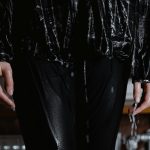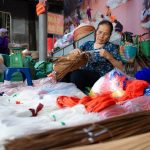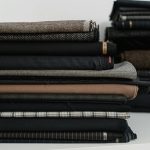Imagine you’re hiking in a sudden downpour, relying on your jacket to keep you dry. However, as you exert yourself, you start to feel damp inside, raising a critical question: how do you find the right balance between breathability and waterproofing in outdoor fabrics? Understanding this paradox not only influences your comfort but can also impact your performance in challenging conditions. Let’s explore what makes a fabric truly effective for your needs.
Table of Contents
Key Takeaways
- Waterproof fabrics block water entry but can restrict airflow, impacting breathability during physical activities.
- Hydrostatic head ratings indicate waterproof capability, while MVTR measures moisture escape, highlighting the balance needed for optimal performance.
- High waterproof ratings can hinder breathability, making it essential to consider activity level and weather conditions when selecting fabrics.
- Technologies like Gore-Tex and eVent enhance breathability while maintaining waterproof properties, showcasing advancements in fabric performance.
- Sustainable practices in fabric production aim to improve both breathability and waterproofing without compromising environmental integrity.
The Basics of Waterproof-Breathable Fabrics
When you’re choosing outdoor gear, understanding waterproof-breathable fabrics is crucial. These materials combine two critical features: they keep water out while allowing moisture to escape. This balance is key for comfort during activities like hiking or climbing.
Waterproof-breathable fabrics typically use a membrane or coating, which blocks water droplets but permits water vapor from sweat to pass through.
You’ll find various options on the market, each designed for specific conditions. Some are lighter for warmer climates, while others offer more insulation for colder weather.
When selecting gear, consider the activities you’ll be doing and the weather conditions you’ll face. Knowing these basics will help you make informed choices and guarantee you stay dry and comfortable during your outdoor adventures.
Understanding Hydrostatic Head and MVTR
To truly grasp fabric performance, you need to understand hydrostatic head and moisture vapor transmission rate (MVTR).
Hydrostatic head measures a fabric’s waterproof capability, while MVTR indicates how well it allows moisture to escape.
Balancing these two factors is essential for choosing the right fabric for your needs.
Hydrostatic Head Explained
Hydrostatic head is an essential measurement in determining a fabric’s waterproof capabilities. It measures how much water pressure a fabric can withstand before water starts to seep through. Typically expressed in millimeters, a higher hydrostatic head rating means better waterproofing. For example, a fabric with a 10,000 mm rating can resist a column of water that tall before leaking.
When you’re choosing outdoor gear, consider this measurement to guarantee you stay dry in wet conditions.
Remember, while hydrostatic head indicates waterproofness, it doesn’t account for breathability. You’ll want a balance between these two properties for peak comfort.
Understanding hydrostatic head helps you make informed choices for your gear and activities, assuring you stay protected from the elements.
MVTR Significance
Understanding hydrostatic head is just one piece of the puzzle when evaluating outdoor fabrics.
You also need to take into account the Moisture Vapor Transmission Rate (MVTR), which measures how well a fabric allows moisture vapor to escape. A high MVTR indicates that sweat can evaporate efficiently, keeping you dry and comfortable during intense activities.
This is essential for layering systems, where trapped moisture can lead to chilling or discomfort. When choosing a fabric, look for a balance between waterproof capabilities and MVTR. A fabric with high waterproof ratings but low MVTR may leave you feeling clammy.
Ultimately, you want a fabric that offers both protection from rain and breathability to manage perspiration effectively during your outdoor adventures.
Balancing Both Factors
When you’re maneuvering through the world of outdoor fabrics, balancing hydrostatic head with MVTR is essential for peak performance.
Hydrostatic head measures a fabric’s waterproofness, indicating how much water pressure it can withstand before leaking. Conversely, MVTR (Moisture Vapor Transmission Rate) gauges breathability, showing how effectively moisture escapes from inside the fabric.
To achieve ideal performance, you need a fabric that offers a high hydrostatic head for wet conditions while maintaining a suitable MVTR for breathability.
A material with too high a waterproof rating may trap sweat, leading to discomfort. Conversely, a breathable fabric mightn’t keep you dry in heavy rain.
Finding that sweet spot guarantees you stay protected and comfortable, regardless of environmental challenges.
Key Fabric Technologies: A Comparative Overview
As you explore the world of fabric technologies, you’ll find that breathability and waterproofing often come at odds with each other. Different technologies aim to strike a balance between the two.
For instance, Gore-Tex uses a microporous membrane, allowing moisture vapor to escape while blocking water droplets. Similarly, eVent employs a direct venting system for enhanced breathability.
On the other hand, polyurethane coatings offer a lightweight waterproof solution but may sacrifice airflow. For those seeking a more natural option, waxed cotton provides decent waterproofing with some breathability, though it can be heavier.
Ultimately, understanding these technologies helps you choose the right fabric for your needs, whether you’re hiking in the rain or lounging by the pool.
Assessing Waterproofness and Breathability Levels
Choosing the right fabric for your activities means evaluating both waterproofness and breathability levels.
When you’re outdoors, you want to stay dry without overheating. Begin by checking the fabric’s waterproof rating, usually measured in millimeters. A higher number indicates better waterproof capabilities.
Next, assess breathability, often indicated by a rating in grams; this shows how much moisture can escape. Look for fabrics that balance both features, as extreme waterproofing can hinder breathability and vice versa.
Assess breathability through its gram rating, ensuring a balance between waterproofing and moisture escape for optimal comfort.
Conduct a simple test: wear a sample fabric during physical activity and see how it performs.
Finally, consider the climate you’ll encounter. By understanding these levels, you can make an informed choice that meets your specific needs and keeps you comfortable.
The Role of Sustainability in Fabric Innovation
While the demand for high-performance fabrics continues to grow, sustainability has emerged as an essential factor in fabric innovation. You’re likely noticing brands prioritizing eco-friendly materials, like recycled polyester or organic cotton, to reduce their environmental footprint.
These sustainable fabrics not only minimize waste but also promote a circular economy, encouraging recycling and reuse. By choosing materials that require less water and energy during production, you can make a positive impact.
Furthermore, innovative treatments are being developed to enhance breathability and waterproofing without relying on harmful chemicals. As you explore your options, consider how sustainable practices can enhance your outdoor experiences while supporting a healthier planet.
Your choices today can drive demand for a more sustainable future in fabric technology.
Market Trends Shaping the Future of Outdoor Fabrics
As you explore the future of outdoor fabrics, you’ll notice a growing emphasis on innovative fabric technologies and sustainable production methods.
These trends are reshaping how brands approach performance and environmental responsibility.
Staying informed about these changes will help you make smarter choices for your outdoor adventures.
Innovative Fabric Technologies
Innovative fabric technologies are revolutionizing the outdoor industry as brands endeavor to balance breathability and waterproofing. You’ll notice advancements like multi-layer membranes and advanced coatings, which greatly enhance performance.
These materials let moisture escape while keeping water out, ensuring you stay dry and comfortable. Brands are also integrating smart fabrics that adapt to changing conditions, providing ideal ventilation when you need it most.
Lightweight options have emerged, making outdoor gear easier to pack and wear without sacrificing durability. With features like stretch and durability, these fabrics enhance your freedom of movement, making your outdoor experiences more enjoyable.
As you explore new gear, keep an eye on these technologies that promise to elevate your adventures.
Sustainability in Production
Sustainability in production is becoming a crucial focus in the outdoor fabric industry, driven by consumers’ growing awareness of environmental issues.
You’ll notice brands prioritizing eco-friendly materials and practices, such as recycled fibers and low-impact dyes. This shift not only reduces waste but also minimizes carbon footprints, appealing to your desire for responsible consumption.
Manufacturers are investing in renewable energy sources and water-saving technologies to further enhance sustainability.
As you explore outdoor gear, look for certifications like GOTS or bluesign, which guarantee environmentally friendly production processes.
By choosing sustainable fabrics, you support innovation and encourage brands to adopt greener practices.
Ultimately, your purchasing decisions can influence the industry’s direction toward a more sustainable future.
Frequently Asked Questions
How Do Temperature Changes Affect Fabric Breathability and Waterproofness?
As the sun dances across the sky, temperature changes can make fabrics breathe more freely or become stubbornly closed off. You’ll find that heat often enhances breathability while cold can seal off waterproof layers.
Can I Wash Waterproof-Breathable Fabrics Without Damaging Them?
Yes, you can wash waterproof-breathable fabrics, but you should follow the care instructions carefully. Use a gentle cycle, mild detergent, and avoid fabric softeners to maintain their performance and extend their lifespan.
What Are the Signs That My Fabric’s DWR Treatment Is Wearing Off?
You might notice your fabric soaking up water instead of beading, or it feels damp after light rain. If you see these signs, it’s time to contemplate reapplying the durable water repellent treatment.
Are All Waterproof Fabrics Also Breathable to Some Extent?
Not all waterproof fabrics are breathable. Some prioritize water resistance over airflow, trapping moisture inside. When choosing materials, consider your activity level and environment to find the right balance between waterproofing and breathability for your needs.
How Do Different Activities Impact Fabric Performance in Real-World Conditions?
Different activities demand varying fabric performance. When you hike, breathability matters for sweat management, while skiing requires waterproofing. Choose fabrics that cater to your activity, ensuring comfort and protection in real-world conditions.
- Best Velvet Fabric for Upholstery: Durability, Styles & Recommendations - June 22, 2025
- What Is Polyester Velvet? Performance, Care & Affordability - June 22, 2025
- What Is Cotton Velvet? Characteristics, Benefits & Common Uses - June 22, 2025






